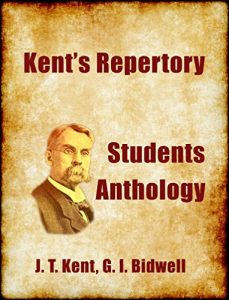This Anthology has been compiled to provide students of Homeopathy, as well as practising Homeopaths, with an educational resource through which to approach and begin the mastery of one of the most influential and valuable reference works in the history of Homeopathy; J T Kent's Repertory of Homeopathic Materia Medica.
The Anthology consists of three main parts:
1. The Repertory itself.
The complete Repertory is included, with an elaborate navigation structure which enables the user to quickly find the section they wish to examine. I have tried to minimise the necessity to scroll through pages to find particular rubrics, a difficult task given the enormous size of the Repertory. All of the original indices are hyperlinked. Every subheading links back to the index for the section in which it appears. There are numerous links (designated "RUBRICS INDEX") which link back to the full list of rubrics. All of the original cross-references are also hyperlinked, making it easy to jump to a related reference within the page or in a different page.
2. G I Bidwell's How to Use the Repertory.
Bidwell's intention was to make the Repertory more accessible to students and budding practioners alike. In this he has succeeded admirably.
His early chapters contain a review of the Organon which is very useful in itself.
The main part of the work is an analysis of forty key remedies in terms of twenty-two major rubrics, relating these back to the repertory. The students who diligently work through these chapters will find themselves in possession of a body of knowledge that will enable them to confidently begin their practice.
3. J T Kent's analysis lectures on the forty remedies chosen by Bidwell.
These lectures are extracted from Kent's Lectures on Homeopathic Materia Medica. They are extensive and detailed. They should be used as an adjunct to the study plan outlined in How to Use the Repertory, to provide a background for the more focused study recommended by Bidwell.
The Anthology consists of three main parts:
1. The Repertory itself.
The complete Repertory is included, with an elaborate navigation structure which enables the user to quickly find the section they wish to examine. I have tried to minimise the necessity to scroll through pages to find particular rubrics, a difficult task given the enormous size of the Repertory. All of the original indices are hyperlinked. Every subheading links back to the index for the section in which it appears. There are numerous links (designated "RUBRICS INDEX") which link back to the full list of rubrics. All of the original cross-references are also hyperlinked, making it easy to jump to a related reference within the page or in a different page.
2. G I Bidwell's How to Use the Repertory.
Bidwell's intention was to make the Repertory more accessible to students and budding practioners alike. In this he has succeeded admirably.
His early chapters contain a review of the Organon which is very useful in itself.
The main part of the work is an analysis of forty key remedies in terms of twenty-two major rubrics, relating these back to the repertory. The students who diligently work through these chapters will find themselves in possession of a body of knowledge that will enable them to confidently begin their practice.
3. J T Kent's analysis lectures on the forty remedies chosen by Bidwell.
These lectures are extracted from Kent's Lectures on Homeopathic Materia Medica. They are extensive and detailed. They should be used as an adjunct to the study plan outlined in How to Use the Repertory, to provide a background for the more focused study recommended by Bidwell.












